From picture-taking to navigation to an evening audiobook, our phones have become an important accessory in the backcountry, and so too has the need to keep them fully charged. That’s not to mention rechargable headlamps, satellite devices, and smartwatches, further adding to the need for reliable energy in the backcountry. Enter power banks. With the best power banks, you can bring enough power on your adventures to keep your essential device, or devices, fully charged and ready to take on the trail.
But there are just so many options out there. What type of power capacity do you need? What about weatherproofing, or weight, or extra features? Here, we’ll compile and discuss the best power banks for hiking to make sure you can keep everything charged up even when you’re miles and miles away from the nearest outlet.
QUICK LIST OF RECOMMENDATIONS
- Best Power Bank Overall – BioLite Charge – 6,000 mAh, 10,000 mAh, 20,000 mAh, 25,000 mAh
- Best Power Bank for Magnetic Charging – EcoFlow Rapid – 5,000 mAh, 10,000 mAh
- Best Power Bank + Lantern Combo – Outdoor Tech Fuel+ – 10,050 mAh
- Most Streamlined Power Bank – SkullCandy Fat Stash 2 – 15,000 mAh
- Best Power Bank for Winter – Zippo Heatbank 3 – 2,600 mAh
KEY CONSIDERATIONS for the Best Power Banks
Let’s start this roundup by taking a close look at the primary buying considerations we should all take into account when weighing different power bank options.
A Note on Navigation
Before we get too deep into power banks, it’s essential for us to make a crucial point about using your phone or other electronics for navigation while in the backcountry. As recommended by the National Park Service, you should never, ever use your phone as your only map or navigation tool! Phones can get damaged, exposed to water, or run out of battery. Therefore, always have a physical topographic map of the area where you’re hiking and know how to use it in conjunction with a compass. These tools can always function, aren’t damaged by water, and, most importantly, don’t require electricity to work. Stay safe out there!
Below, we will make occasional references to the possibility of using your phone for navigation – along with other functions that can drain your battery – but we always recommend including a physical map in your kit, just in case.
Power Capacity
The most important (and mysterious) data we need to consider when finding the best power bank is power capacity. Therefore, let’s take a moment to break down this number to ensure you find exactly what you need.
Most phones and other electronics, along with power banks, measure their battery storage capacity in milliamperes-hours, or mAh. The number reflects how many amperes – amps – the battery can output for one hour before it is depleted. Therefore, a 1000 mAh battery can provide a current of 1000 milliamps for one hour before it needs to be recharged.
Out of the most common electronics found in the backcountry, your phone battery is likely the largest and most used – pictures, music, and navigation apps all use a lot of power. The majority of newer smartphone batteries span the 3,500 mAh to 4,800 mAh range, while older models will be lower than those numbers. We recommend looking up your particular phone model specification before purchasing a power bank in order to ensure you know exactly what kind of power requirements you need.
Luckily, once you determine the capacity of the device you want to keep charged, it’s very straightforward to gauge how effective a potential power bank will be. Simply compare your charging needs to the capacity of the power bank by dividing the power bank’s capacity by your phone’s battery size. For example, if your phone has a 4000 mAh battery and you’re considering a 10,000 mAh power bank, you would be able to fully charge your phone from 0 to 100% about 2.5 times.
From there, you can extrapolate what size power bank you need based on your electronics usage and length of time in the backcountry. If you go hiking with the expressed purpose of leaving electronics behind and only use your phone when you need to, then you can likely opt for a smaller capacity power bank. However, if your phone is your primary camera and navigation tool, and you like to spend evenings in camp with your favorite downloaded podcast, then you’ll need a larger power bank that can keep up with your energy needs.
In conclusion, you may occasionally encounter another unit known as Watt-Hours (WH). This is another method to measure a battery’s size. Luckily, there are online conversion tools to adjust WH into mAh, or (most likely) the manufacturer will also provide mAh somewhere in the specifications.
Port Types
It’s such an easy thing to overlook, but take the extra time to make sure any potential power bank has the right cable port to work with your electronics. Many devices have different types of cables that require different ports, such as USB, micro-USB, and USB-C. So, double-check those ports to avoid the extreme disappointment of trying to charge your phone for the first time and the cable not fitting!
Weight
In short, the more capacity a power bank has, the heavier and clunkier it gets. So, it’s important to weigh your power needs against how much extra weight you want to be carrying on your hike.
Many lower-capacity power bank options will weigh in around 6 ounces or so and provide very lightweight and streamlined power on the trail. But if you need additional energy, then heftier power banks can range anywhere from one to two pounds.
Extra Features
Recently, some brands have been introducing new features to their power banks in order to increase their use. Most commonly, we see light or lantern functionality, which can be handy for evenings in camp. Less commonly, some power banks can double as hand warmers, a very useful feature during winter hikes.
Lastly, some power banks come with the ability to be charged via solar panels. These solar panels are sometimes included with the power bank as a foldable sheet that can be deployed when needed. Other times, solar panels can be purchased as an optional accessory and used to charge the power bank through the input cable, just like plugging it into a wall socket.
Price
Power bank pricing is typically directly linked to the battery capacity. The more powerful the battery, the more you can expect to pay for that extra charge. Generally speaking, we often see prices range from about $35.oo for lightweight and lower capacity options up to $150.00 or more for the beefier options with more charge and features.
Therefore, think about your power needs while in the backcountry, your trip length, and your ideal power bank size. If you’re heading out for longer adventures and often use your electronics, then a higher-capacity power bank could be worth the initial upfront cost. Conversely, if a power bank is more of a backup or emergency tool, then a cheaper, smaller-capacity battery may be a better fit for you.
BioLite Charge
Best Power Bank for Hiking
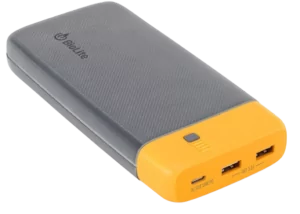
- MSRP: $39.95 – $149.95
- Capacity: 6,000 mAh – 10,000 mAh – 20,000 mAh – 25,000 mAh
- Weight: 5.8 oz (lightest option) – 1 lb 4.8oz (heaviest option)
- Cable Ports
- Input: USB-C
- Output: USB-C, USB-A, magnetic wireless (larger model)
PROS: Multiple capacity options – Reliable – Durable design
CONS: No built-in emergency flashlight
CLOSE LOOK: If there’s one power bank that’s sure to have a version to fit your needs, it’s the BioLite Charge. With four sizing options ranging from the slim 6,000 mAh Charge 20 to the beefy 25,000 mAh Charge 100 Max, you’re sure to find the perfect fit for any type of adventure. By the way, the 20, 40, 80, and 100 battery sizes refer to the capacity in watt-hours, yet another unit of measurement to wrap your head around, but now you know. The BioLite charge has a proven track record in the rough-and-tumble world of backpacking, and provides reliable energy to any number of devices while you’re out hiking. Additionally, all of the output ports can be used simultaneously to charge multiple devices at once, a handy feature at the end of the day if you have multiple electronics that need a little top-up. In fact, the 100 Max version is so powerful that it can even keep a laptop charged while traveling or if you embark on a village-to-village trek and need to stay connected in the evenings.
The BioLite Charge offers no extra functionality or features. It’s a purebred power bank that beautifully fulfills that role. So, if you’re looking for a lantern or flashlight function, then this isn’t the option for you. But if you’re in the market for a well-designed, sleek, and highly effective power bank, then we wholeheartedly recommend the BioLite Charge as one of the best power banks for hiking currently on the market.
VIEW at REI.com
Charge 20 (6,000)Charge 40 (10,000)Charge 80 (20,000)Charge 100 Max (25,000)
VIEW at Backcountry.com
EcoFlow Rapid
Best Power Bank for Magnetic Charging
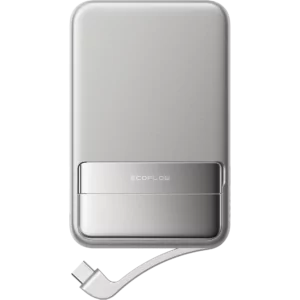
- MSRP: $70.00 – $90.00
- Capacity: 5,000 mAh – 10,000 mAh
- Weight: 6.35 oz (5000 mAh) – 9.1oz (19200 mAh)
- Cable Ports
- Input: USB-C
- Output: USB-C, Magnetic
PROS: Cable-free magnetic charging (if phone has capability) – Integrated USB-C Cable – Fast charging
CONS: Not all phones have magnetic charging
CLOSE LOOK: Cable-free magnetic charging has surged in popularity lately. No cords to worry about breaking or losing, and no worrying about port compatibility, has made this option extremely convenient and effective. Now, assuming your phone has this capability, or you’ve invested in a magnetic charging case, the RAPID power bank from EcoFlow brings this convenience on your adventures. This power bank is extremely sleek with a modern digital display and silver metallic design combined with a built-in USB-C cable for easy charging even if your device isn’t magnetic charging compatible. Of course, if your device isn’t compatible with magnetic charging, the RAPID’s primary feature becomes moot and may not be the best fit. But as magnetic charging continues to propagate through the phone industry, this power bank has extreme potential and is one of the best power banks on the market to serve folks who want to bring that cable-free charging convenience anywhere their adventures take them.
VIEW At REI.com
Outdoor Tech Fuel+
Best Power Bank + Lantern Combo
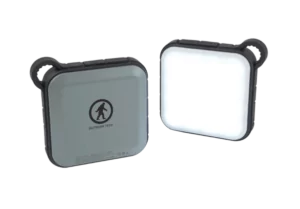
- MSRP: $49.95
- Capacity: 10,050 mAh
- Weight: 9.4 oz.
- Cable Ports
- Input: USB-C
- Output: USB-C, USB-A
PROS: Good price – Included lantern/light functionality – 100% waterproof – Very reliable
CONS: Battery capacity may be a little low for some people
CLOSER LOOK: If you’re interested in getting dual-functionality out of your power bank, then the Fuel+ from Outdoor Tech is definitely worth exploring with its built-in lantern function. Holding 10,050 mAh of charging potential, the Fuel+ can fully charge most phones at least 2.5 times, and the completely waterproof design is appealing for unpredictable backcountry weather. We first started testing Outdoor Tech power banks almost six years ago, and that original power bank is still going strong even today. Therefore, we have enormous respect for this brand’s longevity and reliability, and the Fuel+ appears to continue that trend of durable and long-lasting gear.
We do wish the Fuel+ came in more battery size options (or just a larger size at baseline), as the 10,050 mAh battery may be a tad small for folks heading out for longer trips in the backcountry who use their phone or electronics more frequently. What’s more, using the lantern function further lowers the power available to charge your electronics, reinforcing our wish for a little extra oomph from the battery. Nevertheless, the lantern + power bank combination is effective and useful for almost any camping trip.
View at Outdoor Tech
Skullcandy Fat Stash 2
Most Streamlined Power Bank
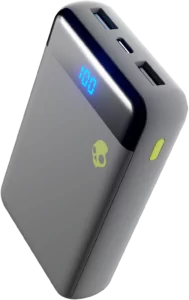
- MSRP: $39.95
- Capacity: 10,000 mAh
- Weight: 7.4 oz.
- Cable Ports
- Input: USB-C
- Output: USB-C, USB-A
PROS: Stylish design – Good battery size – Excellent price – Included charging cable
CONS: Few battery size options – No added functionality – Included cable not the most durable
CLOSER LOOK: Skullcandy’s Fat Stash 2 power bank is effective, easy to use, and very streamlined. A clear digital display shows the battery percentage while USB-A and USB-C ports offer easy options for charging your devices. We wish Skullcandy offered more battery size options, but we’ll take what we can get in the 10,000 mAh size – offering ample charge for smartphones on the trail. The included USB-A/USB-C charging cable is a handy addition that allows you to start charging immediately without needing to make another purchase. However, this included cable isn’t as durable as we’d like, especially for the rough backcountry setting. But regardless of the accessory cable, the Fat Stash 2 offers excellent charging opportunities in the backcountry and is one of the best power banks currently on the market in our eyes.
SkullCandy Fat Stash 2
Zippo Heat Bank
Best Power Bank for Winter
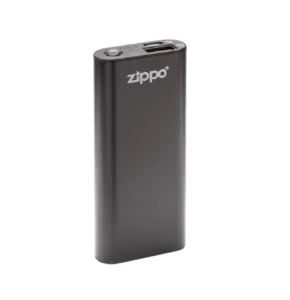
- MSRP: $24.95
- Capacity: 2,600 mAh
- Weight: 2.24 oz.
- Cable Ports
- Input: Micro-USB
- Output: USB-A
PROS: Lightweight – Warming function – Small footprint
CONS: Low capacity – Only USB-A output
CLOSER LOOK: The Heatbank 3 is an ideal power accessory for chilly winter or shoulder season excursions. With dual functionality between a power bank and hand warmer, the Heatbank can use its 2,600 mAh of power to either charge a device once (perhaps not a full charge from empty) or output soothing heat for up to 3 hours. So, for cold days on the trail when you need a little warmth during breaks or at camp, this Heatbank is a solid option. The greatest downside, however, is the low power capacity. With a comparatively small battery, the Heatbank is only practical for single overnights or long day hikes. But if you’re a winter day hiker, the Heatbank can certainly fill that niche and provide power for your device in a pinch.
Zippo HeatBank

More Information About Power Bank
Flying/Traveling with a power bank
Before you go jetting off with a new power bank, it’s important to take a moment to discuss traveling with a power bank on planes. Per FAA guidelines and TSA requirements, all power banks (and any device with lithium-ion batteries) must be stored in your carry-on luggage. This is due to the fact that on very rare occasions, lithium-ion batteries may experience thermal runaway, which occurs due to damage, shorting, or other issues that cause the battery to overheat and potentially catch fire.
Now, this isn’t to scare you away from power banks altogether! Thermal runaway is very rare and extremely unlikely to occur. These flight guidelines are simply to keep the battery in a pressurized environment and on hand so that any potential hazards can be dealt with immediately.
Water exposure
The best power banks for hiking often feature impressive waterproofing that will protect the circuitry and components from damage during heavy rain and, in some cases, full submersion in water. However, it’s important to note that we don’t recommend using your power bank immediately after significant exposure to water. While the internal components may be fine, the connector ports can stay wet for a time, which could disrupt the charging of your device. So, give the power bank some time to completely dry after water exposure before using it to charge up your electronics.
Why Trust Us?
Choosing the right outdoor gear and apparel can be difficult. But at Wildland Trekking, we live and work with hiking gear every single day. It’s an integral part of what we do, and we understand better than anyone how important it is to have the right equipment. In addition to our vast knowledge of backpacking gear, we also offer:
- Independence – our recommendations are not influenced by partnerships or sponsorships with outdoor gear and apparel manufacturers.
- Experience – as one of America’s top guide companies, we take 8,000-10,000 people on hiking and backpacking tours annually. Since our inception in 2005, we have guided more than 75,000 people into the wilderness.
- Cutting Edge Knowledge – we regularly attend trade shows and pay close attention to the leading edge of new developments.
- Up To Date Recommendations – we update our recommendations regularly as new products are developed and released.
- Dedication to our Readers – we know that the gear we select as our top picks will end up in the field with our readers, and we take that responsibility very seriously. We view our readers as guests on our guided trips, just without the guides. We are committed to helping you be as well-outfitted and prepared as possible for your adventures.
*Disclosure: Some of the links above are affiliate links. At no cost to you, we earn a commission on any products purchased through these links. Any proceeds go to supporting our blog and operations. These affiliate links do not influence the products that we include in our gear round-ups. We only recommend products that we 100% support and that we have used in the field.
MORE GEAR RECOMMENDATIONS
Check out our Wildland Gear Guide for more recommendations about hiking, trekking, camping and outdoor gear. We are always adding new products to help our guests and readers make the best choices to outfit their adventures.
- Packing List Quick Links for Wildland Guests
- Wildland Packing List Video
- Best Low Top Hiking Shoes
- Best Boots for Backpacking Trips
- Best Rain Jackets
- Best Rain Pants
- Best Long Underwear
- Best Mid Layers
- Best Tents for Backpacking Trips
- Best Tents for Car Camping Trips
- Best Backpacking Backpacks
- Best Daypacks for Hiking
- Best Trekking Poles
- Best Sleeping Bags
- Best Backpacking Sleeping Pads
- Best Backpacking Stoves
- Best Backpacking Water Filters
- Best Hiking Socks
- Best Backpacking Cookware
- Best Hiking Shirts and Tops
- Best Hiking Pants
- Best Camp Shoes
- Best Hiking Shorts
- Best Hiking Gaiters
- Best Sun Hats
- Best Sun Hoodies





